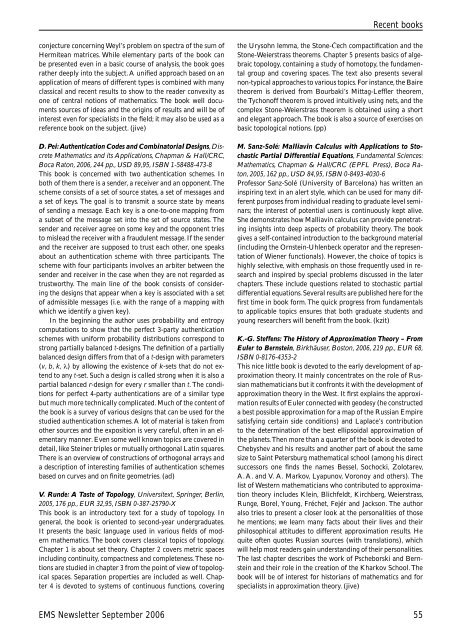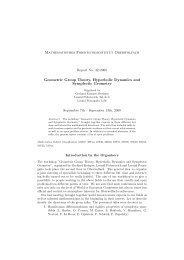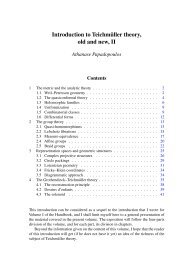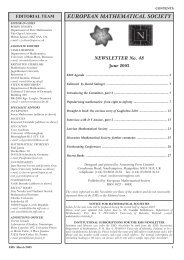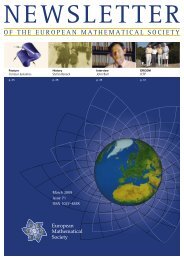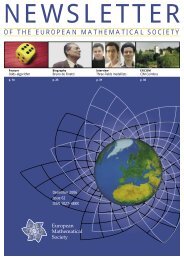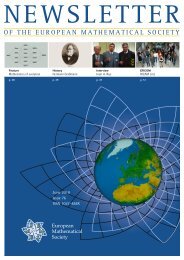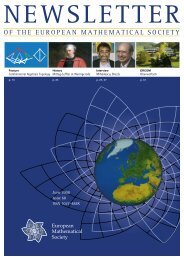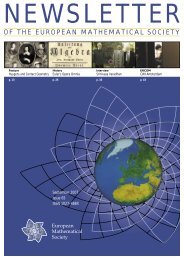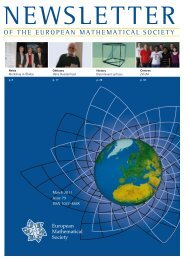OF THE EUROPEAN MATHEMATICAL SOCIETY
OF THE EUROPEAN MATHEMATICAL SOCIETY
OF THE EUROPEAN MATHEMATICAL SOCIETY
You also want an ePaper? Increase the reach of your titles
YUMPU automatically turns print PDFs into web optimized ePapers that Google loves.
conjecture concerning Weyl’s problem on spectra of the sum of<br />
Hermitean matrices. While elementary parts of the book can<br />
be presented even in a basic course of analysis, the book goes<br />
rather deeply into the subject. A unifi ed approach based on an<br />
application of means of different types is combined with many<br />
classical and recent results to show to the reader convexity as<br />
one of central notions of mathematics. The book well documents<br />
sources of ideas and the origins of results and will be of<br />
interest even for specialists in the fi eld; it may also be used as a<br />
reference book on the subject. (jive)<br />
D. Pei: Authentication Codes and Combinatorial Designs, Discrete<br />
Mathematics and its Applications, Chapman & Hall/CRC,<br />
Boca Raton, 2006, 244 pp., USD 89,95, ISBN 1-58488-473-8<br />
This book is concerned with two authentication schemes. In<br />
both of them there is a sender, a receiver and an opponent. The<br />
scheme consists of a set of source states, a set of messages and<br />
a set of keys. The goal is to transmit a source state by means<br />
of sending a message. Each key is a one-to-one mapping from<br />
a subset of the message set into the set of source states. The<br />
sender and receiver agree on some key and the opponent tries<br />
to mislead the receiver with a fraudulent message. If the sender<br />
and the receiver are supposed to trust each other, one speaks<br />
about an authentication scheme with three participants. The<br />
scheme with four participants involves an arbiter between the<br />
sender and receiver in the case when they are not regarded as<br />
trustworthy. The main line of the book consists of considering<br />
the designs that appear when a key is associated with a set<br />
of admissible messages (i.e. with the range of a mapping with<br />
which we identify a given key).<br />
In the beginning the author uses probability and entropy<br />
computations to show that the perfect 3-party authentication<br />
schemes with uniform probability distributions correspond to<br />
strong partially balanced t-designs. The defi nition of a partially<br />
balanced design differs from that of a t-design with parameters<br />
(v, b, k, λ) by allowing the existence of k-sets that do not extend<br />
to any t-set. Such a design is called strong when it is also a<br />
partial balanced r-design for every r smaller than t. The conditions<br />
for perfect 4-party authentications are of a similar type<br />
but much more technically complicated. Much of the content of<br />
the book is a survey of various designs that can be used for the<br />
studied authentication schemes. A lot of material is taken from<br />
other sources and the exposition is very careful, often in an elementary<br />
manner. Even some well known topics are covered in<br />
detail, like Steiner triples or mutually orthogonal Latin squares.<br />
There is an overview of constructions of orthogonal arrays and<br />
a description of interesting families of authentication schemes<br />
based on curves and on fi nite geometries. (ad)<br />
V. Runde: A Taste of Topology, Universitext, Springer, Berlin,<br />
2005, 176 pp., EUR 32,95, ISBN 0-387-25790-X<br />
This book is an introductory text for a study of topology. In<br />
general, the book is oriented to second-year undergraduates.<br />
It presents the basic language used in various fi elds of modern<br />
mathematics. The book covers classical topics of topology.<br />
Chapter 1 is about set theory. Chapter 2 covers metric spaces<br />
including continuity, compactness and completeness. These notions<br />
are studied in chapter 3 from the point of view of topological<br />
spaces. Separation properties are included as well. Chapter<br />
4 is devoted to systems of continuous functions, covering<br />
Recent books<br />
the Urysohn lemma, the Stone-Čech compactifi cation and the<br />
Stone-Weierstrass theorems. Chapter 5 presents basics of algebraic<br />
topology, containing a study of homotopy, the fundamental<br />
group and covering spaces. The text also presents several<br />
non-typical approaches to various topics. For instance, the Baire<br />
theorem is derived from Bourbaki’s Mittag-Leffl er theorem,<br />
the Tychonoff theorem is proved intuitively using nets, and the<br />
complex Stone-Weierstrass theorem is obtained using a short<br />
and elegant approach. The book is also a source of exercises on<br />
basic topological notions. (pp)<br />
M. Sanz-Solé: Malliavin Calculus with Applications to Stochastic<br />
Partial Differential Equations, Fundamental Sciences:<br />
Mathematics, Chapman & Hall/CRC (EPFL Press), Boca Raton,<br />
2005, 162 pp., USD 84,95, ISBN 0-8493-4030-6<br />
Professor Sanz-Solé (University of Barcelona) has written an<br />
inspiring text in an alert style, which can be used for many different<br />
purposes from individual reading to graduate level seminars;<br />
the interest of potential users is continuously kept alive.<br />
She demonstrates how Malliavin calculus can provide penetrating<br />
insights into deep aspects of probability theory. The book<br />
gives a self-contained introduction to the background material<br />
(including the Ornstein-Uhlenbeck operator and the representation<br />
of Wiener functionals). However, the choice of topics is<br />
highly selective, with emphasis on those frequently used in research<br />
and inspired by special problems discussed in the later<br />
chapters. These include questions related to stochastic partial<br />
differential equations. Several results are published here for the<br />
fi rst time in book form. The quick progress from fundamentals<br />
to applicable topics ensures that both graduate students and<br />
young researchers will benefi t from the book. (kzit)<br />
K.-G. Steffens: The History of Approximation Theory – From<br />
Euler to Bernstein, Birkhäuser, Boston, 2006, 219 pp., EUR 68,<br />
ISBN 0-8176-4353-2<br />
This nice little book is devoted to the early development of approximation<br />
theory. It mainly concentrates on the role of Russian<br />
mathematicians but it confronts it with the development of<br />
approximation theory in the West. It fi rst explains the approximation<br />
results of Euler connected with geodesy (he constructed<br />
a best possible approximation for a map of the Russian Empire<br />
satisfying certain side conditions) and Laplace’s contribution<br />
to the determination of the best ellipsoidal approximation of<br />
the planets. Then more than a quarter of the book is devoted to<br />
Chebyshev and his results and another part of about the same<br />
size to Saint Petersburg mathematical school (among his direct<br />
successors one fi nds the names Bessel, Sochocki, Zolotarev,<br />
A. A. and V. A. Markov, Lyapunov, Voronoy and others). The<br />
list of Western mathematicians who contributed to approximation<br />
theory includes Klein, Blichfeldt, Kirchberg, Weierstrass,<br />
Runge, Borel, Young, Fréchet, Fejér and Jackson. The author<br />
also tries to present a closer look at the personalities of those<br />
he mentions; we learn many facts about their lives and their<br />
philosophical attitudes to different approximation results. He<br />
quite often quotes Russian sources (with translations), which<br />
will help most readers gain understanding of their personalities.<br />
The last chapter describes the work of Pscheborski and Bernstein<br />
and their role in the creation of the Kharkov School. The<br />
book will be of interest for historians of mathematics and for<br />
specialists in approximation theory. (jive)<br />
EMS Newsletter September 2006 55


